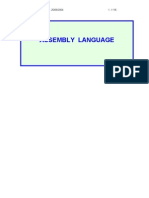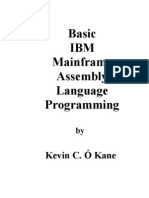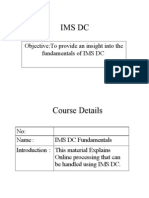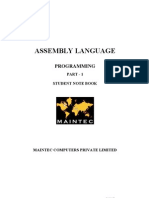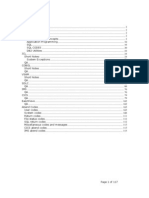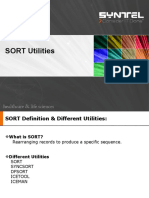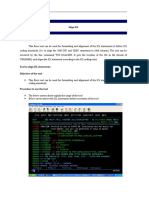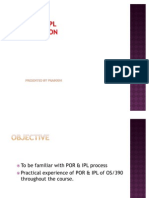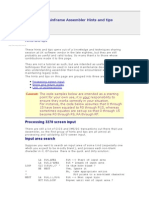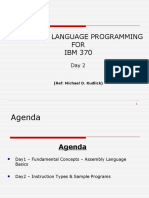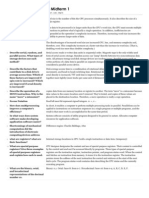IBM Assembly Language Coding (ALC) Part 4
IBM Assembly Language Coding (ALC) Part 4
Uploaded by
Krystal MeethCopyright:
Available Formats
IBM Assembly Language Coding (ALC) Part 4
IBM Assembly Language Coding (ALC) Part 4
Uploaded by
Krystal MeethCopyright
Available Formats
Share this document
Did you find this document useful?
Is this content inappropriate?
Copyright:
Available Formats
IBM Assembly Language Coding (ALC) Part 4
IBM Assembly Language Coding (ALC) Part 4
Uploaded by
Krystal MeethCopyright:
Available Formats
IBM Mainframe Assembler Language Coding
EXERCISE #8
PROGRAM 8. Decimal arithmetic. Modify the last "working" program calculating gross pay and overtime / or average weekly pay to use Packed Decimal calculations. No changes to input or output format. Use a new shell program to start -orcopy the working program and modify it.
211
IBM Mainframe Assembler Language Coding
212
IBM Mainframe Assembler Language Coding
Creating Edited Output There are two instructions in IBM Assembler that provide options for producing readable output on a printed report or terminal screen display. These options include: 1. Insertion of a decimal point in the appropriate position. 2. Replacement of leading zeros by blanks. 3. Insertion of commas or other characters to improve the readability of the output. 4. Use of blank space instead of a plus sign for positive numbers. 5. Use of either a CR or a minus sign suffix for identifying negative numbers. The two instructions used are the EDIT (ED) and the EDIT AND MARK (EDMK). Each of these convert a packeddecimal number to printable EBCDIC code and insert editing characters as specified. They perform this task by means of a concept known as a pattern.
213
IBM Mainframe Assembler Language Coding
Pattern A pattern is made up of the following elements: a fill character (always the 1st byte of the pattern) text characters (comma, period/decimal point, etc.) special editing symbols: X'20' Digit selector - causes the current digit to be taken from the number being operated on. If the digit is non-zero (significant) then it will replace the digit selector in the pattern. Otherwise, the digit selector is replaced by the fill character. Significance starter - selects the current digit just as the digit selector does, but it also forces all subsequent digits to be considered significant. If the current is significant, it replaces the significance starter; else the fill character replaces it.
X'21'
digit
214
IBM Mainframe Assembler Language Coding
Editing Example The pattern and the packed-decimal number are processed left to right. Each byte of the pattern (or result field) either is left unchanged or is replaced. If replaced, it is replaced by the current packed decimal digit or by the fill character of the pattern.
SOURCE DD DD DD DS
PATTERN FC DS DS DS SS DS 4B DS DS
215
IBM Mainframe Assembler Language Coding
Edit
MVC ED
RESULT,PATTERN RESULT,SOURCE
SOURCE 00 34 06 7C
PATTERN 40 20 20 20 20 21 4B 20 20
RESULT 40 40 40 F3 F4 F0 4B F6 F7 3 4 0 . 6 7
216
IBM Mainframe Assembler Language Coding
Edit
MVC ED
RESULT,PATTERN RESULT,SOURCE
SOURCE 00 00 00 1C
PATTERN 40 20 20 20 20 21 4B 20 20
RESULT 40 40 40 40 40 40 4B F0 F1 . 0 1
217
IBM Mainframe Assembler Language Coding
Edit
MVC ED
RESULT,PATTERN RESULT,SOURCE
SOURCE 01 23 45 6C
PATTERN 40 20 20 6B 20 20 21 4B 20 20 40 60
RESULT 40 40 F1 6B F2 F3 F4 4B F5 F6 40 40 1 , 2 3 4 . 5 6
218
IBM Mainframe Assembler Language Coding
Edit
MVC ED
RESULT,PATTERN RESULT,SOURCE
SOURCE 00 00 02 9D
PATTERN 40 20 20 6B 20 21 20 4B 20 20 40 60
RESULT 40 40 40 40 40 40 F0 4B F2 F9 40 60 0 . 2 9 -
219
IBM Mainframe Assembler Language Coding
Edit and Mark - EDMK The only difference between the way the EDIT (ED) and the EDIT AND MARK (EDMK) work is that the EDMK allows you to float a dollar sign to the position you desire. When the significance indicator is off and a significant digit is detected, the address of the corresponding pattern byte is placed into register 1. This address can then be used to insert a dollar sign into the pattern at the desired location. Hence the dollar sign floats. There are two task programmers must perform with the EDMK instruction: 1. The address of the pattern byte immediately following the significance starter should be placed into register 1 before the EDMK instruction is executed. After the EDMK is executed, the address in register 1 must be reduced by 1 in order for the ensuing MVI to place the dollar sign in the byte immediately preceding the first significant digit.
2.
220
IBM Mainframe Assembler Language Coding
Edit and Mark
MVC LA EDMK SH MVI RESULT,PATTERN R1,RESULT+6 RESULT,SOURCE R1,=H'1' 0(1),C'$'
SOURCE
00 00 02 9C
PATTERN
40 20 20 6B 20 21 20 4B 20 20 40 60
RESULT
40 40 40 40 40 40 F0 4B F2 F9 40 40 $ 0 . 2 9
221
IBM Mainframe Assembler Language Coding
Edit and Mark
MVC LA EDMK BCTR MVI
RESULT,PATTERN R1,RESULT+3 RESULT,SOURCE R1,R0 0(R1),C'$'
SOURCE
12 88 8C
PATTERN
40 20 21 20 4B 20 20 40 60
RESULT
40 F1 F2 F8 4B F8 F8 40 40 $ 1 2 8 . 8 8
222
IBM Mainframe Assembler Language Coding
EXERCISE #9. PROGRAM 9. Edited output Modify a working gross pay calculation program to produce edited output. Floating $ . decimal point required , comma if required by the result data Suppress leading zeros before decimal point zero wages = $.00
223
IBM Mainframe Assembler Language Coding
224
IBM Mainframe Assembler Language Coding
The Translate Instruction
TR D1(L,B1),D2(B2)
The Translate instruction uses each byte of the first operand, or 'argument', as an offset to the second operand, or 'table', telling where to go for a new value. Each new value replaces the byte that was used as an offset in the 1st operand. This instruction can be used to translate EBCDIC to ASCII, lowercase to upper, and punctuation marks to some other desired character.
TR
ARGUMENT,TABLE
Before
04 01 03
ARGUMENT
C1 C2 C3 C4 C5 C6 C7
TABLE
After
C5 C2 C4
ARGUMENT
C1 C2 C3 C4 C5 C6 C7
TABLE
225
IBM Mainframe Assembler Language Coding
The Translate Instruction Change ASCII uppercase characters in the input message to their EBCDIC counterparts.
TR TABLE INPUT,TABLE DC DC DC 65XL1'00' C'ABCDEFGHIJKLM' C'NOPQRSTUVWXYZ'
Change EBCDIC uppercase characters in the input message to their lowercase counterparts.
TR INPUT,TABLE2 256AL1(*-TABLE2) TABLE2+C'A' C'abcdefghi' TABLE2+C'J' C'jklmnopqr' TABLE2+C'S' C'stuvwxyz'
TABLE2 DC ORG DC ORG DC ORG DC ORG
226
IBM Mainframe Assembler Language Coding
The Translate and Test Instruction
TRT D1(L,B1),D2(B2)
The Translate and Test instruction uses each byte of the first operand, or 'argument', as an offset to the second operand, or 'table', telling where to go for a value. This value is used to determine the continuation of the operation. If the selected value is zero (X'00'), then the operation continues by fetching and translating the next byte of the first operand, with registers 1 & 2 remaining unchanged. If the value selected is non-zero, the following occurs: 1. 2. The address of the byte from the first operand that was found to be non-zero in the table is loaded into register 1. The value from the table that was non-zero is placed in the low order bits (24-31) of register 2. The high order bits (0-23) of register 2 remain unchanged.
Unlike the translate instruction, the first operand is not changed. Usually the Translate and Test instruction is used to search a field for a specific character. Condition codes: CC = 0 CC = 1 CC = 2 CC = 3 All bytes of the 1st operand were found to be zero in the table. A non-zero byte was found in the table before reaching the end of the first operand. The last byte of the first operand was found to be non-zero in the table. Not used. 227
IBM Mainframe Assembler Language Coding
The Translate and Test Instruction (cont.)
TRT
ARGUMENT,TABLE
Before
04 01 03
ARGUMENT
00 C1 00 00 00 00 00
TABLE
00 00 00 00
REG 1
00 00 00 00
REG 2
After
04 01 03
ARGUMENT
00 C1 00 00 00 00 00
TABLE
addr 2nd byte argument
00 00 00 C1
REG 2
REG 1
CC = 1
228
IBM Mainframe Assembler Language Coding
The Translate and Test Instruction (cont.)
TRT
ARGUMENT,TABLE
Before
04 01 03
ARGUMENT
00 00 00 00 00 00 C1
TABLE
00 00 00 00
REG 1
00 00 00 00
REG 2
After
04 01 03
ARGUMENT
00 00 00 00 00 00 C1
TABLE
00 00 00 00
REG 1
00 00 00 00
REG 2
CC = 0
229
IBM Mainframe Assembler Language Coding
The Translate and Test Instruction Table Look for a plus sign (+) in an input line. TRT TABLE3 INPUT,TABLE3 DC ORG DC ORG 256XL1'00' TABLE3+C'+' X'FF'
230
IBM Mainframe Assembler Language Coding
Move Character Long
MVCL R1,R2
The Move Characters Long instruction can cause data movement of fields exceeding the 256 byte limit of the MVC. A total of 4 registers will be used by this instruction. The even-odd register concept is used the 2 even registers will contain the addresses of the fields involved, and the odd registers will contain the lengths. The contents of the register pairs are altered during the execution of this instruction. At completion, the length field in register R1 + 1 is zero and the address in R1 has been incremented by the original length in R1 + 1. The length field in register R2 +1 has been decreased by the number of bytes copied from the receiving field, and the address in R2 has been incremented by the same amount. Movement is from left to right and ends when the number of bytes specified by the first operand (R1+1) has been moved. If the MVCL is to be used in a loop, the program must reload the registers after each iteration of the loop. As part of execution, the values of the two lengths are compared for the setting of the condition code. Condition Codes: CC = 0 CC = 1 CC = 2 CC = 3 1st and 2nd operand counts are equal 1st operand count low 1st operand count high no movement - destructive overlap - occurs when 1st operand byte is used as a source after data has been moved into it. 231
IBM Mainframe Assembler Language Coding
Move Character Instructions
MVCL
The Move Character Long copies L bytes of data (where L <= 224 -1) from the memory location designated by bits 8-31 of the general register specified in the 2nd operand to the memory location designated by bits 8-31 of the general register specified by the 1st operand. This results in a byte-for-byte move. The MVCL requires 4 registers - 2 sets of even/odd pairs. MVCL R1,R2
232
IBM Mainframe Assembler Language Coding
Move Character Long Example: Clearing 500 bytes to blanks.
LA R4,LONGONE LA R5,500 LA R6,LONGONE L R7,SPACEPAD MVCL R4,R6 . . . . DS 0F DC X'40000000' DS CL500
SPACEPAD LONGONE
233
IBM Mainframe Assembler Language Coding
Move Character Long
MVCL
R4,R6
****** BEFORE ******
00 02 08 50 REG 4 Addr. 1st op. 00 00 01 F4 REG 5 Length 1st op.
00 02 08 50 REG 6 Addr. 2nd op.
40 00 00 00 REG 7 Length 2nd op.
****** AFTER ******
00 02 0A 44 REG 4 Addr. 1st op.
00 00 00 00 REG 5 Length 1st op.
00 02 08 50 REG 6 Addr. 2nd op.
40 00 00 00 REG 7 Length 2nd op.
234
IBM Mainframe Assembler Language Coding
Move Character Long Example: Destructive Overlap (Would execute as a MVC instruction.)
LA LA LA L MVCL . . . DS DC DS DS R4,TARGET R5,20 R6,TARGET-10 R7,PADLENTH R4,R6 Rec fld addr Rec fld length Send fld addr Send fld length c.c. = 3
PADLENTH OUTLINE TARGET
OF X'F0000014' CL50 CL50
235
IBM Mainframe Assembler Language Coding
Move Character Long Example: Non-Destructive Overlap
LA LA LA L MVCL . . . DS DC DS DS R4,TARGET-10 R5,20 R6,TARGET R7,PADLENTH R4,R6 Rec fld addr Rec fld length Send fld addr Send fld length c.c. = 0
PADLENTH OUTLINE TARGET
OF X'F0000014' CL50 CL50
236
IBM Mainframe Assembler Language Coding
Compare Logical Character Long
CLCL R1,R2
The Compare Logical Characters Long can test equal or unequal length fields. When comparing unequal length fields, a padding character is used to even the two fields temporarily. The "even-odd" register concept is used - the 2 even registers will contain the addresses of the fields involved, and the odd registers will contain the lengths.
237
IBM Mainframe Assembler Language Coding
Compare Logical Character Long (cont.)
CLCL
4,2
Before:
00 00 82 5E REG 4 Addr. 1st op. 00 00 53 A2 REG 2 Addr. 2nd op. 00 00 00 0C REG 5 Length 1st op. 40 00 00 09 REG 3 Length 2nd op.
STORAGE:
825E - C1 E2 E8 D3 C4 40 C7 D5 40 E2 F3 F8 53A2 - C1 E2 E8 D3 C4 40 E6 F3 F9
After:
00 00 82 64 REG 4 Addr. 1st op. 00 00 53 A8 REG 2 Addr. 2nd op. 00 00 00 06 REG 5 Length 1st op. 40 00 00 03 REG 3 Length 2nd op.
CC = 1 238
IBM Mainframe Assembler Language Coding
Miscellaneous Directives
Print on Print Off Print Gen -
a program listing will be created (default). no program listing will be created. All statements generated by a macro are printed. No statements generated by a macro are printed (default). Constants are printed in full in the listing. Constants are not printed in full in the listing. Only the first 8 bytes will be printed (default). This suspends the most recently established key words of a print directive. This restores the key words of the most recently suspended print directive. PRINT ON,NOGEN,NODATA
Print Nogen -
Print Data Print Nodata -
Push Print
Pop Print
E.g.
239
IBM Mainframe Assembler Language Coding
Table Search and Program Loop Control Programs use tables to define sets of values and to reference those values during program execution. A program table, sometimes called an array, contains a set of related values which can be referenced based on one or more variables. Each position in a table is called a table entry. The data items in a table are called table elements. There are two types of elements - the argument and the function. When using a variable to search the table argument, the variable is called a search argument.
240
IBM Mainframe Assembler Language Coding
Table Search and Program Loop Control example:
LA LA MVI FLTLOOP EQU CLC BE LA BCT B SWITCHON EQU MVI BYPASS EQU . . . FLTTABL EQU TABLNTRY DC DC DC DC DC #ENTRIES EQU . R3,FLTTABL R4,#ENTRIES SWITCH,X'00' * FLTNUM,0(R3) SWITCHON R3,L'TABLNTRY(R3) R4,FLTLOOP BYPASS * SWITCH,X'FF' * SPECIAL FLIGHT TABLE NBR OF ENTRIES IN TABLE RESET SWITCH LOOK FOR SPECIAL FLIGHT YES-GO TURN SWITCH ON NO-POINT TO NEXT TBL ENTRY LOOP BACK NO SPECIAL FLIGHT FOUND FOUND IT
* C'012' C'104' C'255' C'381' C'510' (*-FLTTABL)/L'TABLNTRY
(In a work block - not in the program)
FLTREC FLTNUM DS DS . . . DS 0CL80 CL3
SWITCH
241
IBM Mainframe Assembler Language Coding
Table Search and Program Loop Control Example:
LA LA EQU CLC BE LA BCT B EQU MVC EQU . . R3,FLTTABL POINT TO FLIGHT TABLE R4,NBRNTRYS NBR OF ENTRIES IN TABLE * FLTNBR,0(R3) DO WE HAVE A HIT? PROCESS YES R3,L'FRSTNTRY(R3) NO-POINT TO NEXT ENTRY R4,FLTLOOP LOOP BACK BYPASS * 4(L'PAXNBR,R3),PAXNBR *
FLTLOOP
PROCESS BYPASS
(This table is in a data record - not in the program)
FLTTABL EQU * FRSTNTRY DS CL8'1098XXXX' * CURRENT DS CL8'3031XXXX' * CONTENTS DS CL8'0821XXXX' * OF THE DS CL8'5590XXXX' * FLIGHT DS CL8'0327XXXX' * TABLE NBRNTRYS EQU (*-FLTTABL)/L'FRSTNTRY . . . FLTREC DS 0CL80 FLTNBR DS CL4 PAXNBR DS CL4
242
IBM Mainframe Assembler Language Coding
EXERCISE #10. PROGRAM 10. Edit file input records using TRT. Input: Records accessed by GET macro. Each record has a name field, a numeric reference code and a complaint count. nameeeeee ### #otherdataotherdata Process: Validate that the name field contains only alpha characters or blanks (use TRT). Valid record - count it, save the name and numeric reference number for later display, accumulate the number of complaints. Invalid record - count it and get another record. Output: Display the numeric reference in col 1. followed by a blank followed by the name. (more)
243
IBM Mainframe Assembler Language Coding
EXERCISE #10 (continued)
OUTPUT (continued) After all good record lines have been displayed, output a blank line followed by (starting in col 4.) TOTAL:bGOODbnnbbBADbnnbbCOMPLAINTSbnn. b = blank space. nn = totals of records or complaints. Miscellaneous: Maximum input records = 20. Write program ZOO5ii (new shell ZOO5II). Prior to testing LOAD ZOO1IE ZOO8II ZOO9IE ZOOAIE From T1 screen on small test system enterB@INIT (response is DATABASE INITIALIZED) After GET macro, R1 will point to first byte of an input record UNLESS R1 is zeros which means no more input records. To test your code - b@alc3+
244
IBM Mainframe Assembler Language Coding
Exercise 1 - Data Definition
For this exercise, code the appropriate DS or DC statement in the "skeleton" program that was sent to you. Rename the program to EXR1yi ("yi" means "your initials"). After you have finished coding the statements in the program, assemble it by using the PARSASM exec. Examine the object code to verify the accuracy of each instruction. 1. Define five 10-byte areas that will contain character type data.
2. Define a 6-byte area that will contain packed decimal data.
3. Define seven fullword data areas.
4. Define a binary constant with a value of hex C4. Use implied length.
5. Define two halfword constants, each with a value of -256.
6. Define 3 packed decimal constants containing the value of 27, -9658, and 326. Each one will be 4 bytes long. Use only one data definition instruction for all three.
last updated 02/09/01
245
IBM Mainframe Assembler Language Coding
Exercise 1 - Data Definition
7. Define a 19 byte constant with the text: WSPN TRAINING CLASS
8. Define a constant with hex value 2171FACE.
9. Define eight zoned decimal constants, each of them 3 bytes long with a value of zero.
10. Define a 132 byte constant consisting of all blanks.
246
IBM Mainframe Assembler Language Coding
Exercise 2 - Move Instructions
For questions 1 - 9, show the contents of the fields requested after the given operation is performed. Each instruction builds on the previous one. Also, identify those instructions which are incorrectly coded. To assemble this code with PARSASM place the following just after the "YOUR CODE GOES HERE" comment in your sample program.
DUMMY JADE OPAL ROCK TOTAL DATA $IS$ DSECT DS DS DS DS DS CSECT USING LA MVC MVC MVC MVC CL4 CL5 CL7 CL4 CL20 DUMMY,R4 R4,EBW000 JADE,JADEC OPAL,OPALC ROCK,ROCKC TOTAL,TOTALC
Follow the above instructions with those in the exercise. Be sure the Define Constants go after all instructions.
JADEC OPALC ROCKC TOTALC DC DC DC DC CL4' ' CL5'STONE' CL7'DIAMOND' ZL4'1234' JADE: JADE: ROCK: ROCK:
1. 2. 3. 4.
MVC MVC MVI MVC
JADE,OPAL JADE+2(2),ROCK+3 ROCK,X'C6' ROCK,OPAL+1
last updated 02/09/01
247
IBM Mainframe Assembler Language Coding
Exercise 2 - Move Instructions (cont.)
5. 6. 7. 8. 9.
MVI MVC MVC
OPAL(2),=C'A' JADE,JADE ROCK-1(2),OPAL+1
OPAL: JADE: OPAL: ROCK: OPAL: JADE:
MVC MVC
OPAL,=X'40' JADE,X'40'
10. Write the code needed to take the 6 bytes that register 3 is pointing to and move them 2 bytes past the address that register 5 is pointing to.
11. Use one MVZ instruction to change the last byte of the value in TOTAL to a printable numeric character.
TOTAL = X'F1F2F3C4'
12. Write the move instructions necessary to fill a 20 byte field called DATA with asterisks.
DATA DS CL20
248
IBM Mainframe Assembler Language Coding
Exercise 3 - Integer Arithmetic
Using the following data to answer the questions below. Code them in your sample program and load and test for results. DS FIRST DC SECOND DC THIRD DC FOURTH DC FIFTH DC OF XL8'0000007200000080' H'12' F'100' F'-25' H'16'
1. Put SECOND into register 5 and multiply it by literal 50. 2. Add FOURTH to register 5. 3. Divide the sum in register 5 by SECOND. 4. Subtract a halfword of 25 from the sum in register 5. 5. Square the sum found in register 5. 6. Add the last 4 bytes of FIRST to the sum in register 5. 7. Write the instructions necessary to compare the result obtained with the value of FIFTH. What is the condition code setting?
249
IBM Mainframe Assembler Language Coding
250
IBM Mainframe Assembler Language Coding
Exercise 4 - Branching and Compares
Given the following CLC instruction, which branch (A or B) will be taken for each of the operand values defined in questions 1 to 5. Or if an exception or fall-thru occurs, please specify. CLC A. B. 1. OHIO DC MAINE DC OHIO DC MAINE DC OHIO DC MAINE DC OHIO DC MAINE DC OHIO DC MAINE DC OHIO,MAINE BH BL CLEVELAND BANGOR
C'ABC' C'123' X'51' B'01010001' C'121' CL3'$$$' P'25' P'-25' Z'-12' C'-12'
2.
3.
4.
5.
last updated 12/29/99
251
IBM Mainframe Assembler Language Coding
Exercise 4 - Branching and Compares (cont.)
6.
Write the compare logical instruction that will compare 7 bytes of data found 5 bytes from the beginning of the address found in register 5, with 7 bytes of data pointed to by register 4. Include a branch instruction that will cause a branch to the tag NOGOOD when the result of the compare indicates that the first operand is either less than or greater than the second operand (use an extended mnemonic).
7.
Code the following into your sample program, load and test it. Write the code necessary to add each element of tables X and Y together storing the result in table Z. Write this code using a BCT for loop control. Data Definitions: X Y DC DC F'1,2,3,4,5,6,7,8,9,10,11,12' F'1,2,3,4,5,6,7,8,9,10,11,12'
Z DS
12F
252
IBM Mainframe Assembler Language Coding
Exercise 5 - Load and Store
1. 2.
Increment register 3 by 8 without using a storage field. Code a data area called REGAREA that is 16 fullwords long and the instruction that will place the contents of registers 0 - 7 into the data area beginning with the 4th fullword.
3.
Put a X'C1' into the right-most byte of register 6 without affecting any other bytes.
4.
Transfer the contents of register 15 into register 7.
5.
Code a 5 byte field called BYTE5 and the instruction that will put the rightmost byte of register 5 into the middle byte of the field.
6.
Code a 3 byte field called TEMP1 and the instruction that will place the address of the field into register 6.
7.
Place into register 4 the contents of a fullword at SUM23 plus a displacement of 4.
8.
True or False: Register 0 should never be used as a base register.
253
IBM Mainframe Assembler Language Coding
254
IBM Mainframe Assembler Language Coding
Exercise 6 - DSECT
Construct and assemble a DSECT that will consist of the following fields: 10 bytes of non-essential data 22 bytes reserved for character data 5 bytes reserved for packed decimal data 6 bytes reserved for character data 7 bytes reserved for zoned decimal data 7 bytes of non-essential data
After the assembly is complete, examine the listing to see the effect a DSECT has on the location counter.
255
IBM Mainframe Assembler Language Coding
256
IBM Mainframe Assembler Language Coding
Exercise 7 - Altering Bits
Questions 1 & 2 should be coded into your sample program and tested for results. 1. BIN1 has a value of B'00001000' BIN2 has a value of B'00010000' What is the value of BIN1 after each of these instructions (assume BIN1 has its original value for each instruction): a. OC b. OI c. OI d. OI BIN1,BIN2 BIN1,B'00001000' BIN1,B'10000000' BIN1,X'33'
2. BIN1 has a value of B'00001000' BIN2 has a value of B'00010000' What is the value of BIN1 after each of these instructions: a. NC b. NI c. NI BIN1,BIN2 BIN1,B'11111110' BIN1,X'80'
257
IBM Mainframe Assembler Language Coding
Exercise 7 - Altering Bits (cont.)
3. What value, if any, could be used to turn off all bits in a byte with an OR instruction?
4. You have just unpacked a field into OUT1, defined as CL7. Write the instructions needed to ensure that the sign indicator in the rightmost byte is equivalent to hex F.
5. Write an instruction to set TEMPFELD to binary zeros regardless of its current contents.
6. Write the instructions necessary to swap the values of TEMP1 and TEMP2 without using any other storage areas.
258
IBM Mainframe Assembler Language Coding
Exercise 8 - Decimal Arithmetic
Given the following instructions and operand values, show the contents, in hex, of the result field. Also, identify those instructions which are incorrectly coded. Ignore the fact that TPF reentrant code will give you assembly errors. 1.
MP CHANGE,STORE CHANGE DC PL6'60' STORE DC PL3'6'
2.
MP
SAVE1,SAVE1+1(2)
SAVE1
DC PL3'6'
3.
DP
FIELD1,FIELD2
FIELD1 DC PL7'10005' FIELD2 DC PL3'100'
4.
DP
ABC,DEF
ABC DEF
DC PL2'100' DC PL2'10'
5.
DP
X,Y Y
DC PL5'20245' DC P'25'
259
IBM Mainframe Assembler Language Coding
Exercise 8 - Decimal Arithmetic (cont.)
6.
SP
CHANGE,STORE
CHANGE STORE
DC PL3'60' DC PL1'6'
7.
AP
FIELD1,FIELD2
FIELD1 FIELD2
DC PL7'10005' DC PL3'100'
8. AP
ABC,DEF
ABC DEF
DC PL2'100' DC PL2'10'
9. SP
X,Y
X Y
DC PL5'20245' DC P'25'
260
IBM Mainframe Assembler Language Coding
Exercise 9 - Decimal Data Operations
Given the following instructions and operand values, show the contents, in hex, of the result field. (Ignore reentrant issues.) 1.
RATE DC CL4'8293' PACK RATE,RATE
RATE
2.
INFO DC P'1734' PACK INFO,INFO TEMP DC P'125' DISC DC P'120' ZAP TEMP,DISC INFO DC P'1734' LAST DS CL6 UNPK LAST,INFO
INFO
3.
TEMP
4.
LAST
5. For the following instruction, what restriction applies to the field GREEN?
ZAP COLOR,GREEN
6. Code the instructions necessary to multiply MILES by RATE in packed decimal format. Declare any variables needed.
MILES RATE DC DC CL3'241' CL2'18'
261
IBM Mainframe Assembler Language Coding
Exercise 9 - Decimal Data Operations (cont.)
7. Shift and round to dollars and cents the following value: 109237876452C Assume the value given shows 5 digits to the right of the decimal point in a field named PKDNUM.
8. Given the following Compare Packed instruction, determine which branch (A, B, or C) will be taken for each of the operand values defined. If an exception occurs, please specify.
CP A. B. C. a. FLDA FLDB FLDA FLDB FLDA FLDB FLDA FLDB FLDA FLDB DC DC DC DC DC DC DC DC DC DC FLDA,FLDB BE BL BH LABEL1 LABEL2 LABEL3
PL15'12' P'16' P'-10652' P'10652' P'-102' X'0000102D' P'1' P'201' P'300' Z'300'
BRANCH
b.
BRANCH
c.
BRANCH
d.
BRANCH
e.
BRANCH
262
IBM Mainframe Assembler Language Coding
Exercise 10 - Creating Readable Output
Show the results of the EDIT operations that use the following source field values and patterns. Indicate blank spaces with the lower case letter b.
SOURCE EDIT PATTERN 402020206B2020214B20606060 4020204B202020 5C20206B202020 6020216B202020 40202021 402021204B202040C3D9 4020202020215C RESULT
1. 2. 3. 4. 5. 6. 7.
0010000D 04725C 00056D 00002C 000C 00014C 12001D
8.
Show the edit pattern required to print a 9 digit social security number with dashes between the 3rd and 4th, and the 5th and 6th characters. Do not suppress leading zeros of the SSN itself. Assume the SSN is in packed decimal format in a 6-byte field.
263
IBM Mainframe Assembler Language Coding
Exercise 10 - Creating Readable Output (cont.)
9. Write the edit pattern, output area and instructions required to edit a 7-digit source field. Provide for 'check protection (asterisk fill). Use a comma and decimal point where needed and always print the two decimal positions. Print a static dollar sign. Sample data: 0445681F
10.Convert a 5-byte packed field to a formatted result with 2 decimal positions. Always print the "ones" position and all digits to the right. Use a floating dollar sign plus commas and decimal points where needed. Also use a space followed by a minus sign to indicate negative amounts. Sample data: 012019034D
264
IBM Mainframe Assembler Language Coding
Exercise 11 - Special Instructions
1. Write an instruction to test bits 0 and 1 in a one-byte field called BIN1. If both bits are on, branch to BOTHON; if only one is one, branch to ONEON. If neither is on, continue with the next instruction.
2. Write the MVCL instruction that will copy 381 bytes of data from the address contained in register 6 to the address contained in register 4. Also, write any other required preliminary instructions that will cause all registers to contain the proper values prior to execution of the MVCL instruction.
3. Write a move instruction moving GOAL to TARGET using length attribute (L') rather than the explicit or implicit length.
TARGET GOAL DS DC CL8 XL8'F1F2F3F4F5F6F7F8'
265
IBM Mainframe Assembler Language Coding
Exercise 11 - Special Instructions (cont.)
4.
Write the translate table and the translate instruction that will take the constant shown below and translate the data to these values: F1 = A, F2 = B, F3 = C.
NUMBER DC X'F1F2F3F1F2F3F1F2F3'
5.
Write an Execute instruction and a Move instruction using the combination of the two to move a variable amount of data. The length will be stored in a halfword field called VARDAT and the sending and receiving field addresses are stored in registers 6 and 10 respectively.
266
You might also like
- IBM Assembly Language Coding (ALC) Part 1Document68 pagesIBM Assembly Language Coding (ALC) Part 1Krystal Meeth100% (7)
- Modbus Address Table Delta PLCDocument3 pagesModbus Address Table Delta PLCMauricio M Lucero60% (15)
- Interview Questions for IBM Mainframe DevelopersFrom EverandInterview Questions for IBM Mainframe DevelopersRating: 1 out of 5 stars1/5 (1)
- COBOL Programming Interview Questions: COBOL Job Interview PreparationFrom EverandCOBOL Programming Interview Questions: COBOL Job Interview PreparationRating: 4.5 out of 5 stars4.5/5 (2)
- Assembly Language Coding (ALC) Part 3Document80 pagesAssembly Language Coding (ALC) Part 3Krystal Meeth100% (3)
- Assembly Language Coding (ALC) Part 2Document62 pagesAssembly Language Coding (ALC) Part 2Krystal Meeth100% (3)
- Churchil AssemblerDocument116 pagesChurchil AssemblerSaravanan BhojanNo ratings yet
- MVS: Basic Operations: Student GuideDocument70 pagesMVS: Basic Operations: Student GuideBalaji ChandrasekaranNo ratings yet
- Nice Assembly ProgrammingDocument140 pagesNice Assembly Programmingprakashcawasthi100% (6)
- Ims DCDocument49 pagesIms DCapi-3853979100% (2)
- Ims DC KMDocument115 pagesIms DC KMramumaxcc0No ratings yet
- Assembler BookDocument454 pagesAssembler BookMadhan Raja100% (2)
- Cics Tutorials MODIFIEDDocument188 pagesCics Tutorials MODIFIEDVikram RamakrishnanNo ratings yet
- AssemblerDocument469 pagesAssemblerprakash_tseNo ratings yet
- Mainframe S390 Assembler ProgrammingDocument36 pagesMainframe S390 Assembler ProgrammingconnectbalajirNo ratings yet
- Tips Sort - JCLDocument16 pagesTips Sort - JCLtiziphoraNo ratings yet
- 12 - More On JES2 Job LogDocument11 pages12 - More On JES2 Job LogasimNo ratings yet
- AMODE and RMODEDocument8 pagesAMODE and RMODEMainframe for everyoneNo ratings yet
- Mainframe FAQ - IMP With IMSDocument117 pagesMainframe FAQ - IMP With IMSAvishek SahaNo ratings yet
- Useful Tricks Using Dfsort and IcetoolDocument7 pagesUseful Tricks Using Dfsort and Icetoolmukesh100% (1)
- Sort FinalDocument17 pagesSort FinalYeddula Padmaja ReddyNo ratings yet
- REXX Tool - Align The JCL StatementsDocument5 pagesREXX Tool - Align The JCL Statementsmukesh100% (3)
- Por & Ipl HoDocument33 pagesPor & Ipl HoNagendra SrikumarNo ratings yet
- Xpeditor Screen ShotsDocument8 pagesXpeditor Screen Shotskrkmff100% (1)
- AssemblerDocument117 pagesAssemblerSreenivas Rao100% (1)
- Cics Class 04Document15 pagesCics Class 04HarithaNo ratings yet
- CA7 OperationalDocument24 pagesCA7 OperationalSamay100% (1)
- IBM Mainframe Assembler - Hints and TipsDocument7 pagesIBM Mainframe Assembler - Hints and TipsNigthstalker100% (2)
- BPXBatchDocument18 pagesBPXBatchNishank KhorgadeNo ratings yet
- DFSORTDocument958 pagesDFSORTbtxps5No ratings yet
- IBM 370 Assembly Language - Day2Document26 pagesIBM 370 Assembly Language - Day2kamakshigari123No ratings yet
- REXX Programming: Arsalan-MeenalDocument19 pagesREXX Programming: Arsalan-MeenalKunalNo ratings yet
- DFSORT Tricks PDFDocument79 pagesDFSORT Tricks PDFvani.sathis8072100% (1)
- Static and Dynamic CallDocument19 pagesStatic and Dynamic CallThrinadh Kiran Kumar100% (1)
- Main Concepts in OPCDocument9 pagesMain Concepts in OPCRahul Kumar KNo ratings yet
- Z OS ISPF Day 1Document31 pagesZ OS ISPF Day 1NagfaceNo ratings yet
- Rexx 1Document115 pagesRexx 1Deepak Dada100% (1)
- IMS Transaction ManagerDocument147 pagesIMS Transaction ManagerBalaji Kishore Kumar100% (2)
- Cics Day-IDocument35 pagesCics Day-Ichinu267100% (1)
- Tso Short Reference Notes: Default Function and PF Key SettingsDocument15 pagesTso Short Reference Notes: Default Function and PF Key SettingsVinothkumar RamakrishnanNo ratings yet
- ImsddDocument28 pagesImsddjibinjamesd100% (1)
- File Processing With REXXDocument13 pagesFile Processing With REXXNilesh M JainNo ratings yet
- CA7 PrasannaDocument18 pagesCA7 PrasannasubashbashNo ratings yet
- MVS JCL Utilities Quick Reference, Third EditionFrom EverandMVS JCL Utilities Quick Reference, Third EditionRating: 5 out of 5 stars5/5 (1)
- DB2 11 for z/OS: Intermediate Training for Application DevelopersFrom EverandDB2 11 for z/OS: Intermediate Training for Application DevelopersNo ratings yet
- DB2 11 for z/OS: SQL Basic Training for Application DevelopersFrom EverandDB2 11 for z/OS: SQL Basic Training for Application DevelopersRating: 4 out of 5 stars4/5 (1)
- DB2 11 for z/OS: Basic Training for Application DevelopersFrom EverandDB2 11 for z/OS: Basic Training for Application DevelopersRating: 5 out of 5 stars5/5 (1)
- IBM i5/iSeries Primer: Concepts and Techniques for Programmers, Administrators, and System OperatorsFrom EverandIBM i5/iSeries Primer: Concepts and Techniques for Programmers, Administrators, and System OperatorsNo ratings yet
- COBOL Basic Training Using VSAM, IMS and DB2From EverandCOBOL Basic Training Using VSAM, IMS and DB2Rating: 5 out of 5 stars5/5 (2)
- Voice Activated Traffic Management System Using Apr 9600 Based On Embedded SystemDocument7 pagesVoice Activated Traffic Management System Using Apr 9600 Based On Embedded SystemInternational Journal of Scientific Research and Engineering StudiesNo ratings yet
- Lab - MelatiDocument7 pagesLab - MelatiHaziq HafizNo ratings yet
- ARM Instruction Set Quick Reference CardDocument6 pagesARM Instruction Set Quick Reference CardNaeem UllahNo ratings yet
- Chapter - 1 Basic Structure of Computers: 1.1 Computer TypesDocument46 pagesChapter - 1 Basic Structure of Computers: 1.1 Computer TypesTameem AhmedNo ratings yet
- Unit IqaDocument44 pagesUnit IqaCitdhyd AriseNo ratings yet
- 08-Shift and RotateDocument22 pages08-Shift and Rotatefakhar_fastNo ratings yet
- Coa 2..2Document42 pagesCoa 2..2Raman Ray 105No ratings yet
- General Aptitude: 01. Ans: (D) Sol: Means To Cause To Go Round or RotateDocument44 pagesGeneral Aptitude: 01. Ans: (D) Sol: Means To Cause To Go Round or Rotateromesh1998No ratings yet
- UHFReader18 Demo Software User's Guidev2.1Document18 pagesUHFReader18 Demo Software User's Guidev2.1Jack WyhNo ratings yet
- Module 4Document82 pagesModule 4Rakesh LodhiNo ratings yet
- Chapter 5-DATA TYPE AND DATA REPRESENTATIONSDocument25 pagesChapter 5-DATA TYPE AND DATA REPRESENTATIONSVongai MubaiwaNo ratings yet
- HTTP P.quizletDocument3 pagesHTTP P.quizletAileen LamNo ratings yet
- Ssi InterfaceDocument22 pagesSsi InterfaceecutronicNo ratings yet
- Computer Architecture Research Project.Document30 pagesComputer Architecture Research Project.ScribdTranslationsNo ratings yet
- Problem Set 2Document4 pagesProblem Set 2bijan shresthaNo ratings yet
- MBus 03 eDocument26 pagesMBus 03 eVoicu StaneseNo ratings yet
- Siemens Hmi AdapterDocument15 pagesSiemens Hmi AdapterjsmarduqueNo ratings yet
- Параметры Fanuc 10Document240 pagesПараметры Fanuc 10Никита НикитинNo ratings yet
- M32R-FPU: Software ManualDocument192 pagesM32R-FPU: Software ManualВ'ячеслав ІльчукNo ratings yet
- Modicon M218 Logic Controller: Programming GuideDocument184 pagesModicon M218 Logic Controller: Programming GuideBoško VasićNo ratings yet
- University Institute of Engineering Department of Computer Science & EngineeringDocument14 pagesUniversity Institute of Engineering Department of Computer Science & EngineeringSayan KarNo ratings yet
- Done by GCDocument38 pagesDone by GCpakoreNo ratings yet
- Second Operand: Shifted Register: EitherDocument13 pagesSecond Operand: Shifted Register: EitherGilberto VirgilioNo ratings yet
- ch1 FullDocument57 pagesch1 FullNhongTranNo ratings yet
- DVP - Communication ProtocolDocument23 pagesDVP - Communication ProtocolNguyên Nhuệ PhanNo ratings yet
- Siemens s7-300Document95 pagesSiemens s7-300Er. Piush Jindal100% (1)
- Connecting ConveyLinx To Siemens PLCs v1 0Document32 pagesConnecting ConveyLinx To Siemens PLCs v1 0DarichNo ratings yet
- Read Heidenhain TNC PLC DataDocument4 pagesRead Heidenhain TNC PLC DataMartinNo ratings yet
- Siemens TCP Ip Ethernet ManualDocument110 pagesSiemens TCP Ip Ethernet ManualWagner ArantesNo ratings yet










